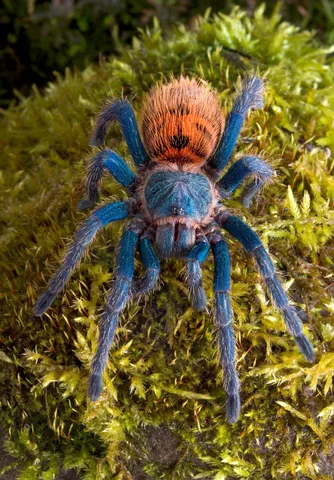Green Bottle Blue Tarantula Overview
The Green Bottle Blue Tarantula (GBB), scientifically known as Chromatopelma cyaneopubescens, is a visually stunning and popular species among tarantula enthusiasts. Native to the arid regions of Venezuela and Trinidad, this tarantula is prized for its vibrant coloration and relatively docile temperament, making it a captivating pet. Its striking appearance, featuring a metallic blue carapace, vibrant orange abdomen, and green-blue legs, is a significant draw for hobbyists. This guide provides comprehensive insights into caring for a GBB, ensuring a healthy and thriving life for your arachnid companion. Understanding their specific needs is paramount to providing the best possible care, allowing you to enjoy their beauty and fascinating behaviors.
Appearance and Characteristics
The Green Bottle Blue Tarantula is one of the most visually appealing tarantula species, its common name accurately reflecting its striking color pattern. The carapace, or the top shell of the cephalothorax, displays a brilliant metallic blue hue that shimmers in the light. The abdomen is adorned with vibrant orange hairs, creating a beautiful contrast. The legs are typically a gradient of green and blue, completing the captivating color palette. These tarantulas are not only beautiful but also relatively large, with females often reaching a leg span of up to 6 inches. Males are usually smaller. The combination of their colors and size makes them a centerpiece in any tarantula collection. Observing their colors is one of the most rewarding aspects of owning a GBB, as they become more vibrant with age and proper care.
Temperament and Behavior
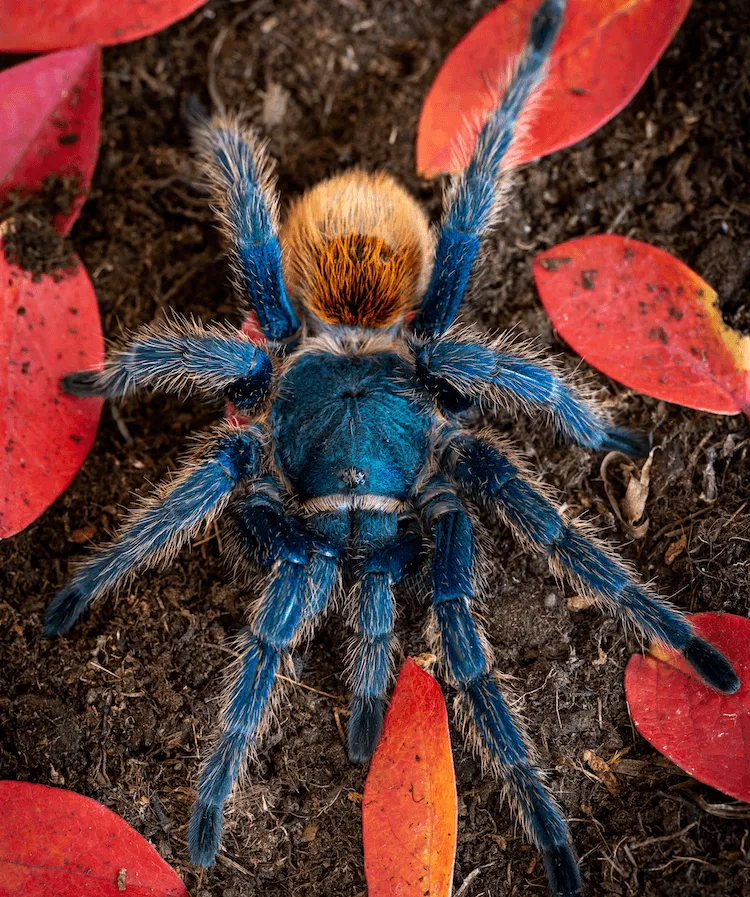
GBBs are generally considered to be a relatively docile species, which contributes to their popularity. However, like all tarantulas, they are still capable of defensive behaviors. They are known to be a bit skittish and may flick urticating hairs if they feel threatened. These hairs cause irritation to the skin and eyes and are a defensive mechanism. They also have the potential to bite if provoked, although this is rare. Green Bottle Blues are also known for webbing extensively, often creating elaborate webs throughout their enclosures. This webbing is part of their natural behavior, providing them with both a home and a hunting ground. Their activity level is moderate compared to some other tarantula species. They spend a considerable amount of time web-building, hunting, and resting. Therefore, understanding their temperament and behavior will help you in providing the best care.
Habitat Setup
Creating the right habitat is crucial for the well-being of your Green Bottle Blue Tarantula. A properly designed enclosure mimics their natural environment and provides the necessary conditions for their health and happiness. This involves selecting the correct enclosure size and type, choosing suitable substrate and decor, and maintaining optimal temperature and humidity levels. By paying careful attention to these elements, you can ensure that your GBB thrives in captivity and exhibits its natural behaviors. This will also allow you to observe your tarantula in a safe and comfortable environment, enhancing your enjoyment of this unique pet. A well-designed habitat is the foundation of successful GBB care.
Enclosure Size and Type
Choosing the right enclosure size is important for your Green Bottle Blue Tarantula. Juvenile GBBs can be housed in smaller enclosures, such as a 5-gallon terrarium. As they grow, they will need more space. Adult GBBs require a terrarium that is at least 10 to 20 gallons, with dimensions that allow them to move freely and web extensively. The enclosure should be taller than it is wide, as GBBs are arboreal, meaning they prefer to climb and live off the ground. A secure lid is essential to prevent escape. It’s crucial that the lid is well-ventilated to allow for proper airflow, but the ventilation holes should be small enough to prevent the tarantula from escaping. Glass or clear plastic enclosures are ideal because they allow for easy viewing of your tarantula. A well-sized and secure enclosure is essential for the tarantula’s safety and well-being.
Substrate and Decor
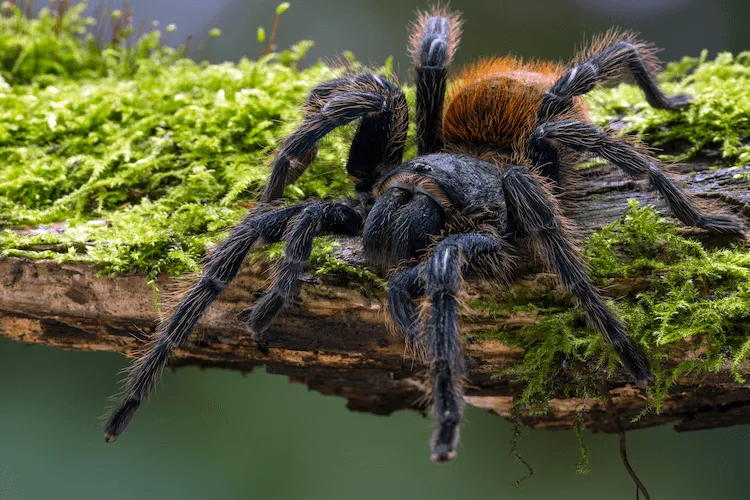
The substrate and decor should replicate the tarantula’s natural habitat. A good substrate choice for a GBB is a mix of coco fiber, vermiculite, and a small amount of peat moss. This mixture helps retain humidity while allowing for proper drainage. The substrate should be several inches deep to allow the tarantula to burrow and create webbing. Decor in the enclosure should include a sturdy piece of cork bark or other climbing material. This provides a place for the tarantula to climb, hide, and web. Artificial plants can also be added to provide additional cover and visual appeal. Ensure all decor is securely placed and free of any sharp edges that could harm your tarantula. Proper substrate and decor create a secure and enriching environment for your GBB.
Temperature and Humidity
Maintaining the correct temperature and humidity is essential for the health of your GBB. The ideal temperature range is between 75 to 85 degrees Fahrenheit (24 to 29 degrees Celsius). A heat mat placed on the side of the enclosure (never underneath) can help maintain this temperature. Humidity levels should be kept between 60% and 70%. You can monitor humidity with a hygrometer. To maintain humidity, lightly mist the enclosure with dechlorinated water every few days, or as needed, to keep the substrate slightly damp. Avoid over-misting, as this can lead to mold growth. Proper temperature and humidity levels help your GBB with molting, feeding, and overall well-being. Monitoring and maintaining these conditions are crucial aspects of GBB care.
Feeding Your Green Bottle Blue
Proper feeding is vital to keep your Green Bottle Blue Tarantula healthy and active. Understanding the right diet, feeding frequency, and hydration methods will ensure your tarantula thrives. A well-fed GBB is more likely to molt successfully and exhibit its natural behaviors. This includes active hunting, web-building, and overall vitality. Providing a balanced diet and following a regular feeding schedule are fundamental aspects of successful tarantula care, providing your pet with the energy it needs to live a long and healthy life.
Diet and Food Options
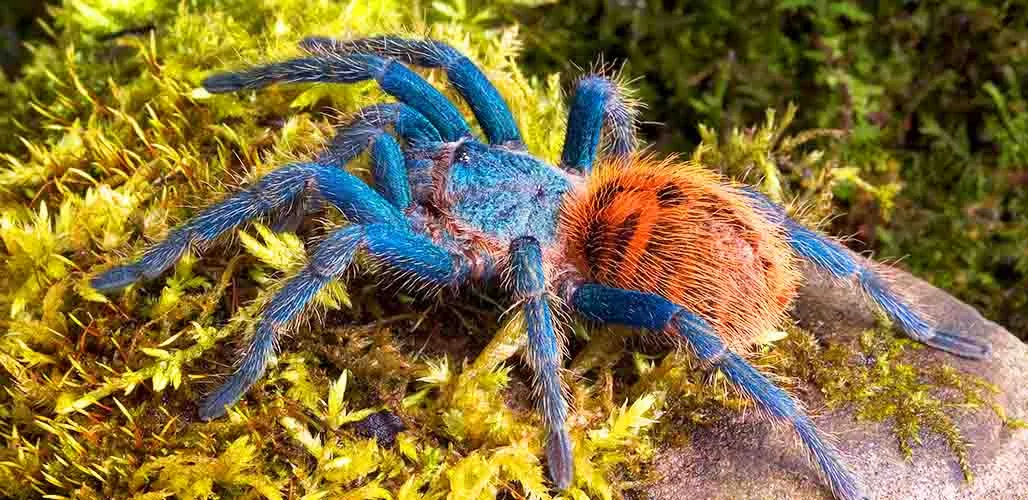
GBBs are carnivores, and their diet should consist primarily of live insects. Crickets, mealworms, and roaches are excellent food options. Variety is key to ensure your tarantula receives a balanced diet. Offer a mix of prey items to provide different nutrients. Always ensure the insects you feed are gut-loaded, meaning they have been fed nutritious food before being offered to your tarantula. This enriches the nutritional value of the insects. Avoid feeding insects that have been exposed to pesticides or chemicals. The size of the prey should be appropriate for the size of your tarantula. The prey should be no larger than the tarantula’s body. Be cautious when introducing larger prey items, as they may injure your tarantula during a struggle.
Feeding Frequency
The feeding frequency depends on the age of the tarantula. Spiderlings (young tarantulas) should be fed 2-3 times a week. Sub-adults can be fed once or twice a week. Adult GBBs can be fed once every 1-2 weeks. However, it is important to observe your tarantula’s feeding habits. If your tarantula refuses food, it may be in pre-molt or not hungry. Remove uneaten prey items after 24 hours to prevent stress and potential harm to the tarantula. Always ensure a fresh water source is available, even if the tarantula doesn’t drink often. A consistent feeding schedule, tailored to the tarantula’s age, is essential for optimal health.
Watering and Hydration
Providing a clean water source is essential for your GBB’s hydration. A shallow water dish filled with fresh, dechlorinated water should always be available. This allows the tarantula to drink as needed. Change the water regularly to prevent bacteria growth. Some GBBs may prefer to drink water droplets from misting. Lightly misting the enclosure every few days can also provide hydration. Monitor the water dish and misting to ensure that the substrate does not become excessively wet, which can lead to mold or fungal infections. Proper hydration is critical for the tarantula’s overall health and molting process. Ensure consistent access to fresh water, and maintain appropriate humidity levels to keep your GBB well hydrated.
Handling and Interaction
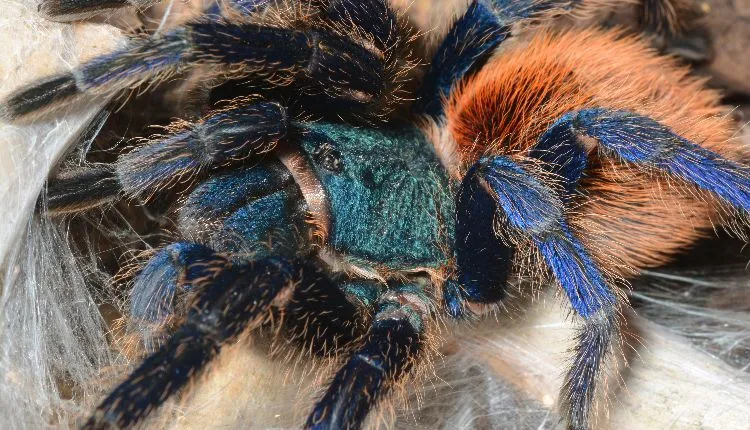
While Green Bottle Blue Tarantulas are relatively docile, handling should be approached with caution. Understanding the best practices for handling and knowing when to avoid it is essential to ensure the safety of both the tarantula and the handler. While it is tempting to interact with these beautiful creatures, it is crucial to prioritize their well-being and avoid unnecessary stress. Responsible handling promotes a positive experience and reduces the risk of injury to both the tarantula and the owner.
When to Handle
It is generally not recommended to handle Green Bottle Blue Tarantulas unless absolutely necessary. Handling can be stressful for the tarantula and may increase the risk of being bitten or triggering their defensive mechanisms. If you must handle your GBB, such as for enclosure maintenance or health checks, do so only when necessary and minimize the time spent handling. Always avoid handling a tarantula that is in pre-molt, as they are more vulnerable and defensive during this period. Never handle a recently molted tarantula until its fangs have hardened. Observe your tarantula’s behavior. If it appears stressed, agitated, or is exhibiting defensive postures, it is best to leave it alone.
Safe Handling Practices
If handling is necessary, always approach the tarantula calmly and gently. Use a soft, wide brush to gently coax the tarantula onto your hand rather than trying to grab it. Handle the tarantula over a soft surface, such as a bed or a carpet, to minimize the risk of injury if it falls. Avoid sudden movements and loud noises, which can startle the tarantula. Be aware that the tarantula may flick urticating hairs if it feels threatened. Wash your hands thoroughly after handling to remove any potential irritants. Always prioritize the tarantula’s safety and comfort when handling. If you are not experienced with handling tarantulas, it is best to avoid it altogether.
Common Health Issues
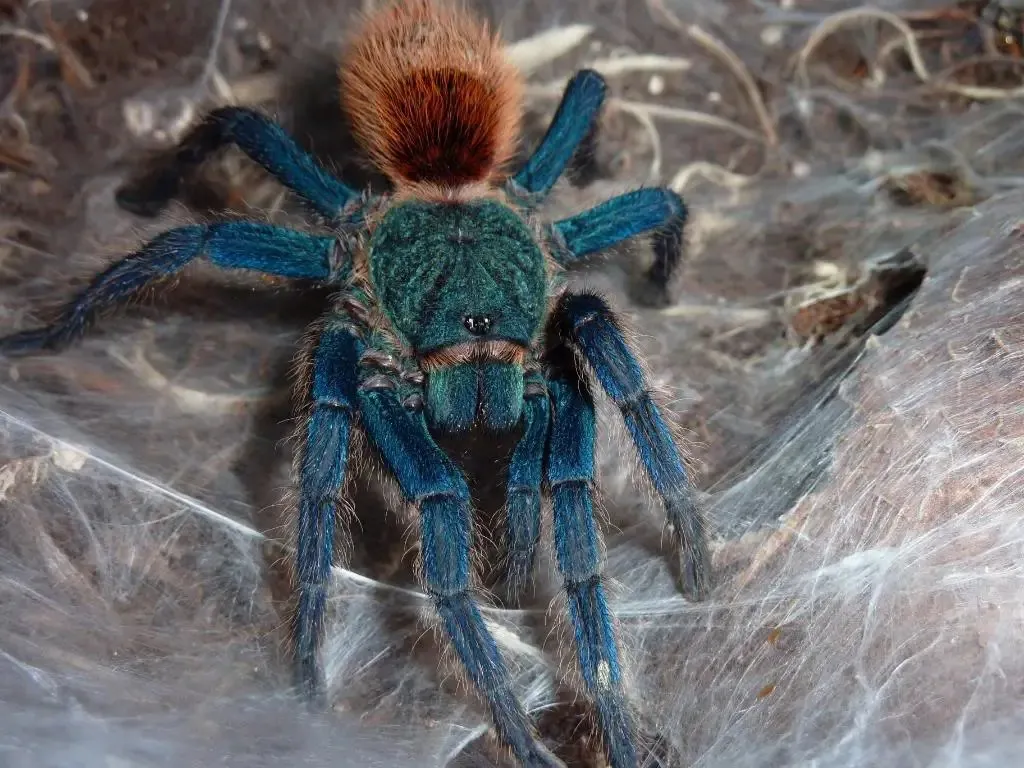
Like all tarantulas, Green Bottle Blues can be susceptible to certain health issues. Understanding these issues, including molting problems and parasites, is crucial for providing proper care and maintaining a healthy environment. Recognizing the signs of illness and knowing how to address them can prevent serious problems and ensure your tarantula lives a long, healthy life. Regular observation of your tarantula and its enclosure can help identify potential issues early, allowing for timely intervention and care.
Moulting
Moulting is a natural process where tarantulas shed their exoskeleton to grow. This process can take several hours to several days. During pre-molt, the tarantula may stop eating, become lethargic, and its abdomen may appear darker or shiny. Provide a safe and undisturbed environment during this period. Do not handle the tarantula during molting, and avoid any disturbances. After moulting, the tarantula will be very vulnerable. Its new exoskeleton is soft and its fangs are not yet hardened. Do not feed the tarantula for a week or until its fangs have hardened. Provide clean water and allow it to rest. Providing the right humidity is essential to ensure a successful molt. A successful molt is a sign of a healthy and thriving tarantula.
Parasites and Diseases
While Green Bottle Blues are relatively hardy, they can still be affected by parasites or diseases. Mites are a common external parasite that can infest tarantulas. Signs of a mite infestation include small, moving dots on the tarantula or its enclosure. If you suspect mites, consult with a veterinarian specializing in exotic pets. Other diseases, such as fungal infections, can occur if the enclosure is too humid or has poor ventilation. Maintaining the correct temperature and humidity, and ensuring good hygiene, is essential to prevent these issues. Regularly clean the enclosure and remove any uneaten food to avoid attracting pests or promoting fungal growth. Always observe your tarantula for any signs of illness or unusual behavior and consult a veterinarian if you have concerns.
Breeding Considerations
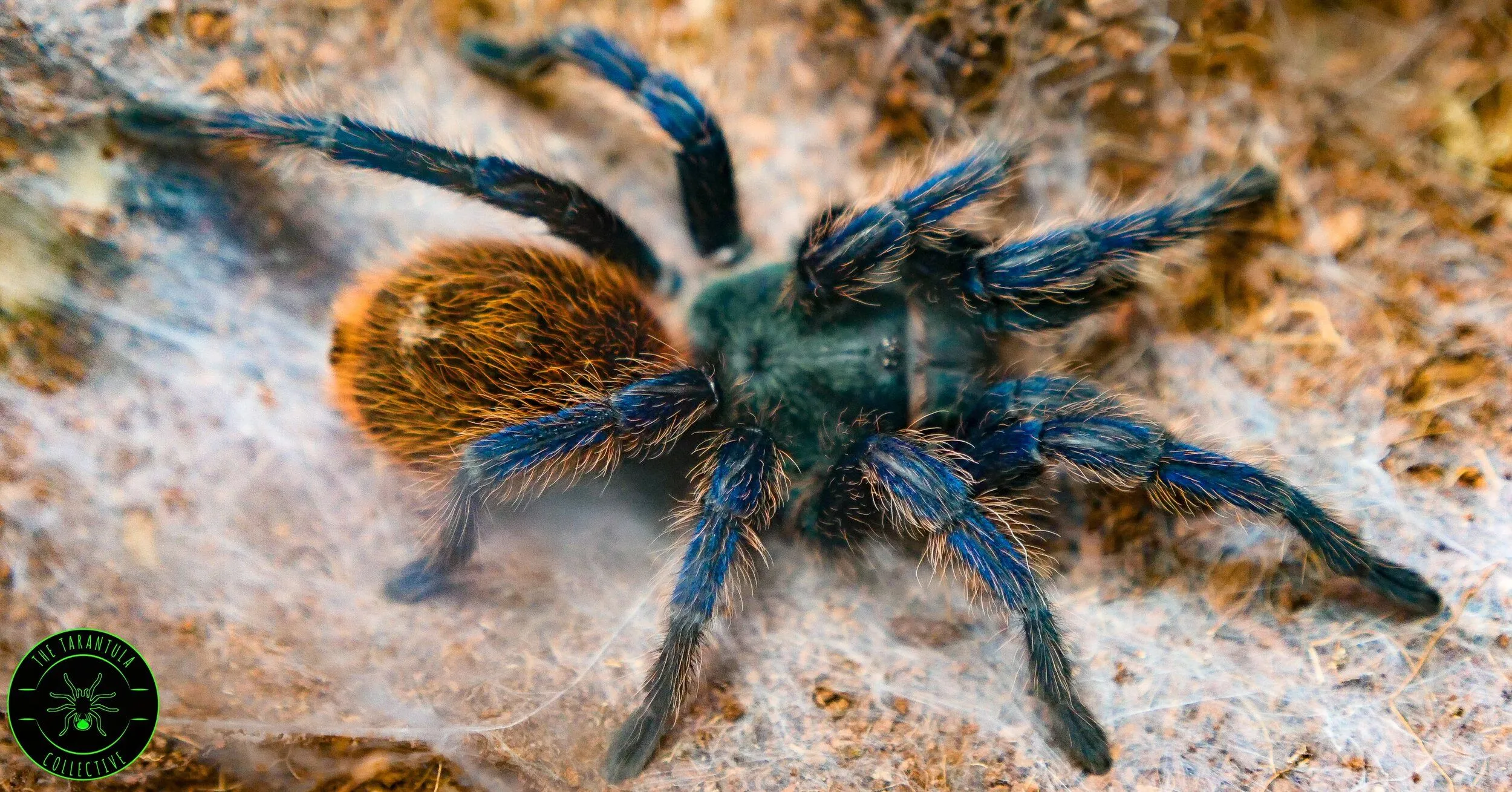
Breeding Green Bottle Blue Tarantulas is a rewarding but complex undertaking. It requires a thorough understanding of the species, including the correct conditions for successful breeding. This includes sexing your tarantulas and understanding the breeding process. Successfully breeding GBBs involves creating the right environment and carefully monitoring the process. It is essential to be prepared for the commitment of raising spiderlings if the breeding is successful. If you are not interested in breeding, it is important to avoid housing males and females together. Breeding GBBs can be a challenging but rewarding experience for experienced tarantula keepers.
Sexing Your Tarantula
Determining the sex of your GBB is a crucial step in breeding. There are two primary methods. The most reliable method is to examine the exuvium (shed skin) after a molt. Look for the presence of spermathecae (sperm storage organs) in females. These are small pouches located between the book lungs. In males, you will find a pair of modified pedipalps called palpal bulbs, which are used for mating. You can also sometimes determine the sex by looking at the underside of the abdomen, but this method is less reliable, especially in younger tarantulas. Accurate sexing is essential for any breeding attempt and can be confirmed with the exuvium after a molt.
Breeding Process
Breeding Green Bottle Blue Tarantulas requires careful planning and preparation. Introduce the female to the male’s enclosure or vice versa, under careful supervision. Be prepared to separate the tarantulas if the female is not receptive or if aggression is observed. Mating behavior can vary. The male will typically drum his pedipalps and approach the female. If the female is receptive, mating will occur. After mating, separate the male from the female to prevent the female from eating him. The female will lay an egg sac containing hundreds of eggs several months after mating. Incubate the egg sac under appropriate conditions. Raising the spiderlings requires significant resources, including small enclosures, food, and careful monitoring. Breeding GBBs requires experience and preparation.
Conclusion
Caring for a Green Bottle Blue Tarantula can be a rewarding experience. By understanding their specific needs, you can provide a suitable environment that allows them to thrive. Following the guidelines on habitat setup, feeding, handling, and health will ensure that your GBB lives a long, healthy, and visually stunning life. Remember to prioritize their well-being, and always be prepared to learn and adapt your care as needed. The Green Bottle Blue is a fascinating species, and with proper care, you can enjoy its beauty and unique behaviors for years to come. Embrace the journey of tarantula ownership, and appreciate the wonder of these remarkable creatures. Enjoy the experience of caring for one of the most beautiful tarantulas in the world!
